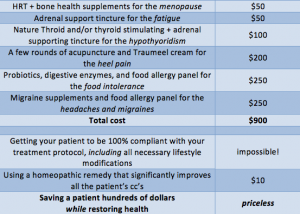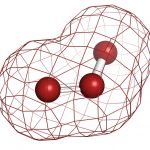Cost-effective Medicine A Way To Answer Our “Highest Calling”
Ashley L. Russell, ND
Jonci Jensen, ND
Rachel’s History
Imagine our patient – a 49-year-old graduate student – presenting to your clinic with chief concerns of headaches and migraines, hypothyroidism, menopause, food intolerance, fatigue, and heel pain. What are some conservative naturopathic treatment recommendations that might come to mind? (See Table 1)
Rachel had been seeing a naturopathic doctor for her chief concerns of headaches and migraines, hypothyroidism, menopause, food intolerance, fatigue, and heel pain. While she had been experiencing some symptomatic relief with naturopathic treatment – a few treatments similar to those listed in Table 1 – she was curious whether homeopathy could offer any additional benefits, and sought out homeopathic care from the SCNM student clinic.
Rachel had been a public relations coordinator for 20 years but had decided to go back to school to pursue a new career in her real passion, anthropology. Having been out of school for so many years, it was a challenge for her to begin taking a full-time course load. With all the young adults in the program, Rachel was also really beginning to feel how long that gap in schooling had been. To make the transition more difficult, prior to starting graduate school her father passed away, which took quite a toll on her emotionally. And while she had 5 adult children that no longer required her constant attention, there were a lot of stressful events that had transpired in her children’s lives over the previous 6 months that were contributing to her own stress. Rachel had also remarried within the last few years and was adjusting to that role. Suffice it to say, Rachel had had her fair share of stress in the last year or so, which did not spare her health. With more and more research demonstrating the link between chronic stress and disease, it appeared that Rachel was no exception to this.1,2
While she had had chronic headaches for “as long as she could remember” and brain fog that started with menopause 4 years prior, graduate school only exacerbated these symptoms. At one point, her headaches were a daily occurrence, with 50% of them progressing to migraines. In addition, she had debilitating fatigue, which made studying quite challenging. She reported that she would study for hours and then “completely blank” on a test when it came time to recall the material. Despite feeling like she wasn’t able to remember the material, she was maintaining a solid A/B average in her classes. While her failing brainpower, fatigue, and headaches were understandably some of her biggest concerns, her most concerning symptom was the recent onset of food intolerance.
This began when one of Rachel’s friends suggested they do a 2-week raw vegan cleanse together. During the cleanse, Rachel felt great; however, she gained 7 pounds while her friend lost 5. She admitted that she probably ate more fruit than veggies during the cleanse, but she certainly didn’t expect to gain weight. However, the real trouble began when she tried to discontinue the cleanse. Any time she attempted to eat protein, she experienced significant gastrointestinal (GI) distress, which included nausea, bloating, abdominal pain, flatulence, diarrhea, and sometimes vomiting; she also experienced brain fog. Due to this extreme reaction to proteins, Rachel found she could only tolerate a piece of fruit for breakfast and some cucumbers, tomato, and avocados for lunch and dinner. The main concern was that by eating so little, Rachel was signaling her body to enter into a “starvation state,” which could exacerbate her hypothyroidism.3 And, of course, a balanced diet, with adequate protein and fat, is essential for a stressed-out graduate student to be able to function.
Homeopathic Case
So, equipped with a trusty repertory and Materia Medicas, Rachel’s homeopathic case was taken. In cases with so many chief concerns, it is easy to get confused about what symptoms to pay attention to and what symptoms to ignore. So in true Hahnemannian style, out of hundreds of symptoms, Aphorism 153 provided some guidance: “…the more striking, strange, unusual, peculiar (characteristic) signs and symptoms in the case are especially, almost exclusively, the ones to which close attention should be given, because it is these above all which must correspond to very similar symptoms in the symptom list of the medicine being sought if it is to be the one most suitable for cure.”4 By letting Rachel describe her symptoms, taking care to avoid “putting words into [the patient’s] mouth or asking a question that can be answered only by yes or no…” (Aphorism 87), the characteristic symptoms became quite clear.4
Her most striking symptom, the one that caused her the most suffering, was an anticipatory anxiety surrounding tests, which started a semester earlier when she received a C in a class. That incident profoundly affected her self-confidence, even though, as mentioned before, she is an A/B student. She became worried that her friends would “realize” that she didn’t know the information. In addition, she experienced severe fatigue during class but would then find that she had a “second wind” before bed, around 8 PM. Among her GI symptoms was abdominal bloating (she reported that she would sometimes look 5 months pregnant!) that was better with burping. Finally, Rachel’s headaches felt like an “emptiness in her forehead” that was better from pressure and worse with motion.
Repertorization & Remedy
As you can see from the repertorization in Figure 1, Lycopodium was the top remedy. But how would it rate when checking for these symptoms in the Materia Medica? Lycopodium covers “apprehensiveness,”5-7 “loss of confidence in himself and everything,”6 “motion agg,”7 “immediately after a (light) meal the abdomen is bloated, full, distended,”8 and “abdominal distention, eructations ameliorates.”9
Causticum was another strong consideration because of the “sensation of an empty space between forehead and brain”7 during headaches. However, upon further reading about Causticum in various Materia Medicas, Lycopodium covered the totality of her characteristic symptoms better than Causticum. So, Rachel was started on Lycopodium 30C, and we had our own anticipatory anxiety (well, more excitement than anxiety) about how she would react.
Follow-up
Lycopodium did not disappoint! At a month follow-up, Rachel reported significant improvement in her symptoms. Her anticipatory anxiety decreased from 8/10 in severity to 3/10 and was occurring less frequently. She’d had no migraines since the previous visit, and only a few headaches. Her gas and bloating were significantly lessened, and she was able to successfully eat protein such as fish and eggs without experiencing any discomfort. Her memory also improved but appeared to have worsened within the previous week or so. She also remembered a symptom that she had forgotten to tell us about during our earlier visits, which had worsened. She had been having left heel pain that was better with moving, though worse upon initial movement. The heel pain actually began several months prior to her initial visit but it had slipped her mind during the initial intake. All she knew is that it had worsened sometime since beginning the Lycopodium.
With such a dramatic improvement in her symptoms, it seemed that she reacted positively to the Lycopodium. However, since her memory had started declining within the last week or so, it appeared that she might have begun to no longer react to the remedy. And since Lycopodium covered her heel pain, it seemed best to increase her potency to 200C.
At Rachel’s next follow-up, she reported continued improvement in her memory and GI symptoms. She still had had no migraines since starting homeopathic treatment, and just a few headaches. Her anticipatory anxiety had completely resolved, as did her heel pain. She even saw improvement in a symptom of heat in the soles of her feet – an improvement that she had not experienced with the initial potency of Lycopodium.
Comments
While she has only been receiving homeopathic treatment for a few months, this dramatic improvement, in both newer and long-standing symptoms, with only a homeopathic remedy, is naturopathic medicine at its best. As Hahnemann so eloquently phrases it, “the physician’s highest calling, his [or her] only calling, is to make sick people healthy.”4
As you reflect back on this case, you may still be wondering, “Why homeopathy? Perhaps avoiding her food allergies, taking a tincture, and weekly acupuncture treatments would have had the same effect.” Those are surely appropriate and reasonable treatments. But with over 48 million Americans lacking health insurance in 2012,10 and uncertainty looming over the effectiveness of the Patient Protection and Affordable Care Act (PPACA) insurance exchanges,11 cost of healthcare is, understandably, a large concern for the United States. Even our very own American Association of Naturopathic Physicians (AANP) – the organization that is tasked with promoting and growing our profession – has an admirable goal of ensuring that Americans know that “naturopathic medicine is safe, effective, and cost-effective.”12 One of the numerous advantages of naturopathic medicine is our large “toolbox” of modalities to choose from when offering treatment options. While nutrition, acupuncture, and botanical medicine are reasonable treatments, if we are truly striving to provide cost-effective medicine for Americans, what makes homeopathy a less reasonable option? As demonstrated in Rachel’s case, homeopathy offers such remarkable health restoration and is the very definition of “cost-effective.”
Yoda once said, “Many of the truths that we cling to depend on our point of view.” Perhaps our profession’s view of homeopathy has not caught up with our view (or the AANP’s view, rather) of how to provide “safe, effective, and cost-effective” medicine. If that is the challenge to us, then perhaps we should challenge our profession to better equip naturopathic doctors with tools like homeopathy in order to reach these lofty goals. Then we may find ourselves more often asking “Why not homeopathy?” when considering our doctoral duty – our highest calling – of making sick people healthy in a cost-effective way.
Ashley L. Russell, ND, graduated from the Southwest College of Naturopathic Medicine in Arizona. She received her BS in Applied Ecology from the University of California, Irvine, where she spent over a year researching the impact of bioremediating plants on Costa Rican soil. She is a naturopathic doctor at Serenity Natural Health Center in Frederick, Maryland, with a focus on women’s health, and is also co-founder of LovempoweR, an organization dedicated to changing women’s health care. In her spare time, Dr Russell enjoys baking vegan, gluten-free treats, hiking, and spending time with her dog, Honey.
 Jonci Jensen, ND, is currently an assistant professor at Bastyr University in San Diego, CA, where she teaches homeopathy, naturopathic medical philosophy, and clinical skills. She recently completed the Standard Homeopathics-funded specialized residency in homeopathy at Southwest College of Naturopathic Medicine. Prior to this, she built a successful practice in Austin, TX. Dr Jensen has a passion for treating acute and severe chronic conditions using homeopathic medicine.
Jonci Jensen, ND, is currently an assistant professor at Bastyr University in San Diego, CA, where she teaches homeopathy, naturopathic medical philosophy, and clinical skills. She recently completed the Standard Homeopathics-funded specialized residency in homeopathy at Southwest College of Naturopathic Medicine. Prior to this, she built a successful practice in Austin, TX. Dr Jensen has a passion for treating acute and severe chronic conditions using homeopathic medicine.
References:
- Cohen S, Janicki-Deverts D, Miller GE. Psychological stress and Ddisease. JAMA. 2007;298(14):1685-1687.
- Cohen S, Janicki-Deverts D, Doyle WJ, et al. Chronic stress, glucocorticoid receptor resistance, inflammation, and disease risk. PNAS. 2012;109(16):5995-5999.
- Brent GA, Davies TF. Hypothyroidism and Thyroiditis. In: Melmed S, ed. Williams Textbook of Endocrinology. 12th ed. Philadelphia, PA: Saunders; 2011: 406-439.
- Hahnemann S. Organon of Medicine. 6th ed. Blaine, WA: Cooper Publishing; 1982.
- Boericke W. Pocket Manual of Homeopathic Materia Medica. 9th ed. San Francisco, CA: Boericke and Tafel; 1927.
- Kent JT. Lectures on Homeopathic Materia Medica. 1st ed. Chicago, IL: 1904.
- Hering C. Guiding Symptoms of Our Materia Medica. Charleston, SC: Nabu Press; 2010.
- Lippe AV. Text Book of Materia Medica. Philadelphia, PA: 1865.
- Allen TF. A Primer of Materia Medica. Philadelphia, PA: Boericke & Tafel; 1892.
- United States Census Bureau. Health Insurance; Highlights: 2012. US Census Bureau Web site. http://www.census.gov/hhes/www/hlthins/data/incpovhlth/2012/highlights.html. Accessed October 29, 2013.
- Roy A. Interactive Map: In 13 States Plus D.C., Obamacare Will Increase Health Premiums By 24%, On Average. September 4, 2013. Forbes Web site. http://www.forbes.com/sites/theapothecary/2013/09/04/interactive-map-in-13-states-plus-d-c-individual-health-premiums-will-increase-by-an-average-of-24/. Accessed September 5, 2013.
- American Association of Naturopathic Physicians. Vision and Goals. AANP Web site. http://naturopathic.org/content.asp?contentid=19. Accessed September 5, 2013.













